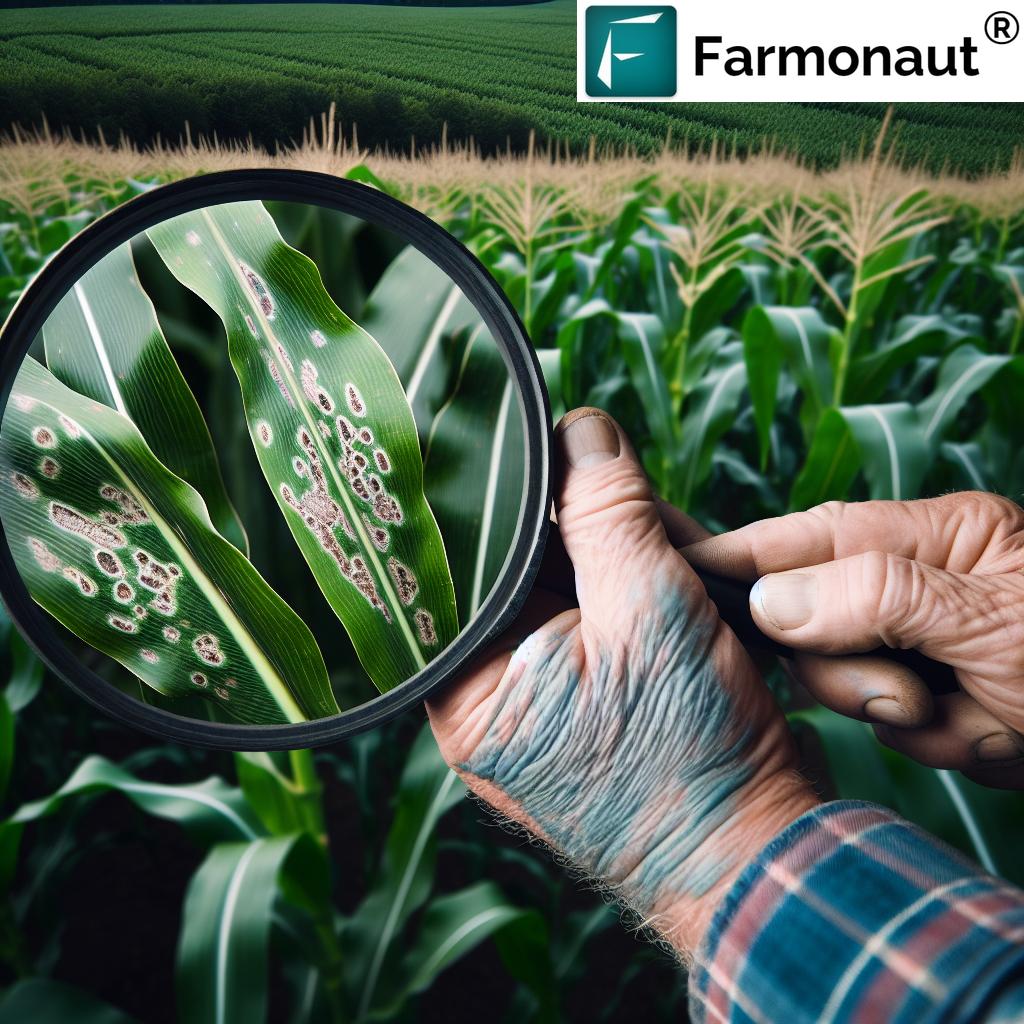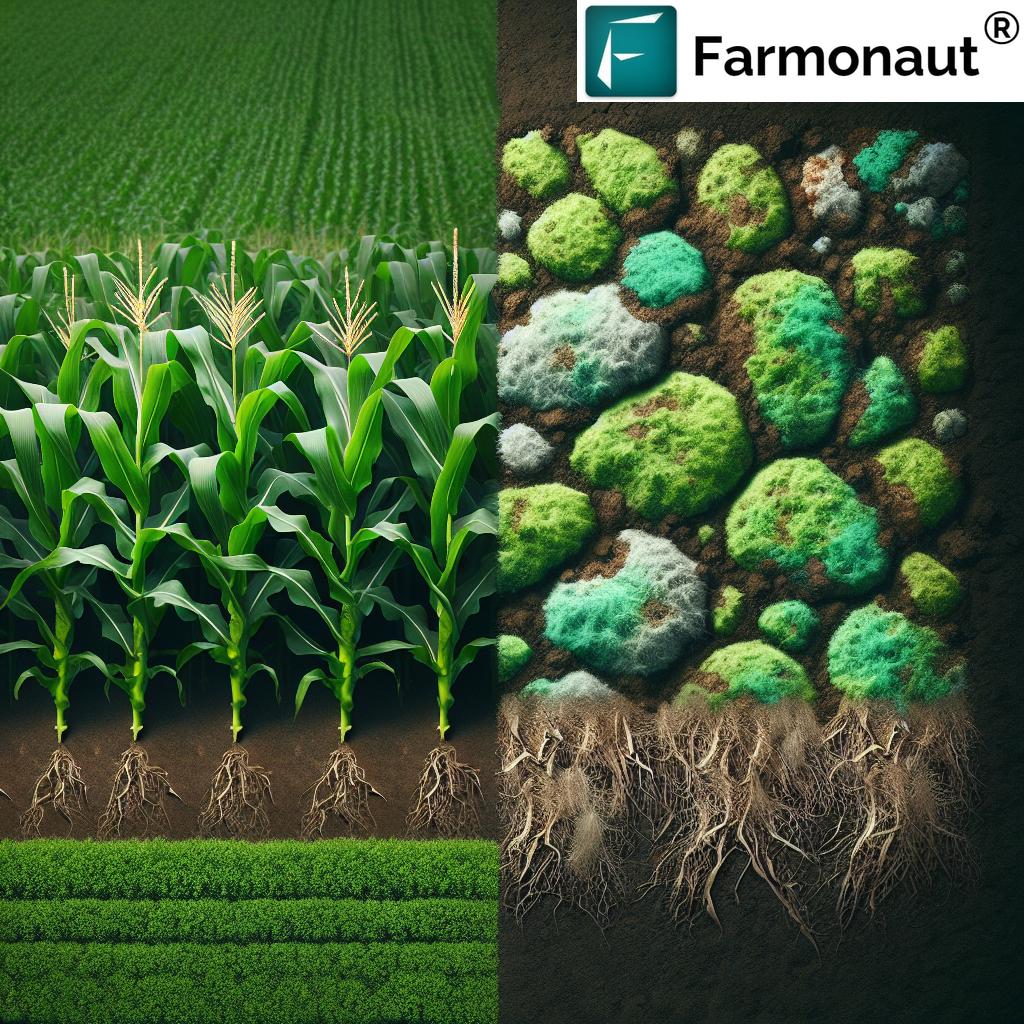Organic vs. Chemical: Controlling Gray Leaf Spot Disease in Corn Fields

As we navigate the challenging landscape of modern agriculture, one of the most persistent threats to corn production is the infamous gray leaf spot disease. This fungal infection can wreak havoc on corn fields, significantly impacting yields and farmer livelihoods. At Farmonaut, we understand the importance of addressing this issue with both conventional and organic approaches. In this comprehensive guide, we’ll explore the intricacies of gray leaf spot disease, its impact on corn plants, and the various methods of control – from organic treatments to chemical solutions.
Understanding Gray Leaf Spot Disease in Corn
Gray leaf spot, caused by the fungal pathogen Cercospora zeae-maydis, is a significant foliar disease affecting corn crops worldwide. The disease thrives in warm, humid conditions and can spread rapidly through infected fields, especially during the critical growing season.
Symptoms and Identification
- Early stages: Small, pinpoint lesions on lower leaves
- Progressive stages: Rectangular, gray to tan lesions bounded by leaf veins
- Advanced infection: Lesions coalesce, leading to leaf blight and premature death of leaves
The characteristic rectangular lesions are a telltale sign of gray leaf spot, distinguishing it from other common corn diseases. As the infection progresses, these lesions can significantly reduce the photosynthetic area of the leaf, impacting overall plant health and yield potential.
Disease Cycle and Spread
Understanding the life cycle of gray leaf spot is crucial for effective management:
- Overwintering: Fungal spores survive on crop residue from previous seasons
- Spring activation: Warm, humid conditions activate spores
- Dispersal: Wind and rain splash spread spores to new corn plants
- Infection: Spores germinate on leaf surfaces, penetrating through stomata
- Lesion development: Visible symptoms appear 14-21 days after infection
- Secondary spread: New spores form on lesions, continuing the cycle
The rapid spread of gray leaf spot, especially in favorable weather conditions, makes early detection and proactive management essential for protecting corn yields.
Impact of Gray Leaf Spot on Corn Production
The effects of gray leaf spot on corn crops can be devastating, leading to significant economic losses for farmers. Here’s how the disease impacts corn production:
- Reduced photosynthesis: Leaf damage decreases the plant’s ability to produce energy
- Weakened stalks: Severe infections can lead to stalk rot and lodging
- Premature death: Heavy infestations can cause plants to die before reaching full maturity
- Yield loss: Severe cases can result in yield reductions of up to 50%
- Quality issues: Infected kernels may have reduced nutritional value and marketability
The economic impact of gray leaf spot extends beyond immediate yield losses. The cost of control measures, potential for increased susceptibility to other pests and diseases, and long-term effects on soil health all contribute to the overall burden on corn producers.
Conventional Chemical Control Methods
Chemical control remains a widely used approach for managing gray leaf spot in corn fields. While effective, it’s important to consider the broader implications of chemical use in agriculture.
Fungicide Applications
Chemical fungicides are often the go-to solution for many farmers dealing with gray leaf spot. Here’s what you need to know about fungicide use:
- Timing is crucial: Application should occur at the first signs of disease or before tasseling
- Product selection: Strobilurin and triazole fungicides are commonly used
- Resistance management: Rotating fungicide classes helps prevent pathogen resistance
- Coverage matters: Thorough application ensures protection of the entire plant
While fungicides can effectively control gray leaf spot, their use comes with considerations:
- Environmental impact: Potential effects on non-target organisms and ecosystems
- Cost: Fungicide applications can be a significant expense for farmers
- Residue concerns: Proper adherence to pre-harvest intervals is crucial
Integrated Pest Management (IPM) Strategies
At Farmonaut, we advocate for an integrated approach to disease management. IPM combines various control methods to minimize economic, health, and environmental risks:
- Cultural practices: Crop rotation, residue management, and planting resistant varieties
- Monitoring: Regular field scouting and weather monitoring to predict disease pressure
- Threshold-based applications: Using fungicides only when disease levels warrant treatment
- Precision application: Utilizing technology for targeted fungicide use
Our satellite monitoring technology at Farmonaut plays a crucial role in IPM strategies by providing early detection of disease outbreaks and enabling precise application of control measures.
Organic Approaches to Gray Leaf Spot Control

As the demand for organic produce grows, so does the need for effective organic control methods for diseases like gray leaf spot. While organic approaches may require more planning and proactive management, they offer significant benefits in terms of sustainability and environmental stewardship.
Cultural Practices
Cultural control methods form the foundation of organic disease management:
- Crop rotation: Rotating corn with non-host crops reduces disease pressure
- Resistant varieties: Planting corn hybrids with genetic resistance to gray leaf spot
- Tillage practices: Incorporating crop residue to reduce overwintering inoculum
- Planting date: Adjusting planting times to avoid peak disease conditions
- Plant spacing: Proper spacing improves air circulation and reduces humidity
Biological Control Agents
Several biological agents have shown promise in controlling gray leaf spot:
- Trichoderma spp.: Fungal antagonists that compete with pathogens
- Bacillus subtilis: Bacteria that induce plant resistance and produce antifungal compounds
- Mycorrhizal fungi: Symbiotic fungi that enhance plant health and resistance
While biological control agents are still an emerging field, they offer exciting possibilities for organic gray leaf spot management.
Organic Fungicides and Plant Extracts
Several organic-approved substances can help in managing gray leaf spot:
- Copper-based fungicides: Broad-spectrum protectants approved for organic use
- Sulfur: Effective against various fungal diseases, including gray leaf spot
- Neem oil: Natural fungicide with multiple modes of action
- Garlic and clove oil extracts: Show antifungal properties in some studies
It’s important to note that organic fungicides often require more frequent applications and may not provide the same level of control as synthetic options. However, when used as part of a comprehensive management strategy, they can be effective in reducing disease pressure.
Farmonaut’s Role in Gray Leaf Spot Management
At Farmonaut, we’re committed to empowering farmers with cutting-edge technology to manage diseases like gray leaf spot more effectively. Our satellite-based monitoring system offers several advantages in the fight against this persistent corn disease:
- Early detection: Our advanced algorithms can identify potential disease outbreaks before visible symptoms appear
- Precision mapping: We provide detailed maps of disease progression across fields
- Targeted treatment: Our data enables farmers to apply treatments only where needed, reducing costs and environmental impact
- Historical analysis: Track disease patterns over time to inform long-term management strategies
By integrating Farmonaut’s technology into your corn management practices, you can take a more proactive and precise approach to controlling gray leaf spot. Learn more about our services at Farmonaut App.
Comparing Organic and Chemical Control Methods
To help you make informed decisions about gray leaf spot management, we’ve compiled a comparison of organic and chemical control methods, including the benefits of Farmonaut’s satellite monitoring:
| Method | Effectiveness | Cost | Environmental Impact | Ease of Implementation |
|---|---|---|---|---|
| Chemical Fungicides | High | Moderate to High | Moderate to High | Moderate |
| Organic Cultural Practices | Moderate | Low to Moderate | Low | Moderate to High |
| Organic Biological Control | Low to Moderate | Moderate | Low | Moderate |
| Organic Fungicides | Low to Moderate | Moderate to High | Low to Moderate | Moderate |
| Farmonaut Satellite Monitoring | High (for early detection) | Low to Moderate | Low | High |
As the table illustrates, each method has its strengths and limitations. Farmonaut’s satellite monitoring stands out for its ability to enhance the effectiveness of both organic and chemical control methods through early detection and precision application.
Implementing an Integrated Approach
At Farmonaut, we believe that the most effective strategy for managing gray leaf spot in corn combines the best aspects of both organic and conventional methods, supported by advanced technology. Here’s how you can implement an integrated approach:
- Start with prevention: Implement cultural practices like crop rotation and resistant varieties
- Monitor closely: Use Farmonaut’s satellite monitoring to detect early signs of disease
- Apply organic methods first: Use biological controls and organic fungicides as a first line of defense
- Use chemical controls judiciously: Apply synthetic fungicides only when disease pressure exceeds economic thresholds
- Continual assessment: Regularly evaluate the effectiveness of your management strategy and adjust as needed
By taking this integrated approach, you can effectively manage gray leaf spot while minimizing environmental impact and optimizing resource use.
The Future of Gray Leaf Spot Management
As we look to the future, several emerging trends and technologies are shaping the landscape of gray leaf spot management in corn:
- Genetic engineering: Development of corn varieties with enhanced resistance to gray leaf spot
- Precision agriculture: Advancements in drone and satellite technology for even more precise disease detection and treatment
- Artificial intelligence: Machine learning algorithms to predict disease outbreaks based on environmental data
- Novel biological controls: Discovery and development of new microorganisms for disease suppression
- Sustainable chemistry: Research into environmentally friendly fungicides with reduced ecological impact
At Farmonaut, we’re committed to staying at the forefront of these advancements, continually improving our technology to provide farmers with the most effective tools for disease management.
Conclusion
Managing gray leaf spot in corn requires a multifaceted approach that balances effectiveness, cost, and environmental stewardship. While chemical controls offer rapid and potent solutions, organic methods provide sustainable, long-term benefits. By integrating these approaches with advanced monitoring technology like Farmonaut’s satellite imaging, farmers can achieve optimal disease control while minimizing environmental impact and maximizing profitability.
We invite you to explore how Farmonaut can revolutionize your approach to corn disease management. Visit our app or check out our API services to learn more about how we can help you protect your corn crops from gray leaf spot and other threats.
FAQ Section
Q: How does gray leaf spot affect corn yield?
A: Gray leaf spot can significantly reduce corn yields by damaging leaf tissue, reducing photosynthesis, and weakening plants. Severe infections can lead to yield losses of up to 50%.
Q: Can organic methods effectively control gray leaf spot?
A: While organic methods may not provide the same level of immediate control as chemical fungicides, a comprehensive organic approach including cultural practices, biological controls, and organic fungicides can effectively manage gray leaf spot over time.
Q: How often should fungicides be applied to control gray leaf spot?
A: The frequency of fungicide applications depends on disease pressure, weather conditions, and the product used. Generally, one to two applications during the growing season are recommended, with the first application around tasseling.
Q: How can Farmonaut’s technology help in managing gray leaf spot?
A: Farmonaut’s satellite monitoring technology provides early detection of disease outbreaks, enables precise mapping of infected areas, and supports targeted treatment applications, helping farmers manage gray leaf spot more effectively and efficiently.
Q: Are there any resistant corn varieties available for gray leaf spot?
A: Yes, many seed companies offer corn hybrids with varying levels of resistance to gray leaf spot. While no variety is completely immune, resistant hybrids can significantly reduce disease severity and yield loss.

